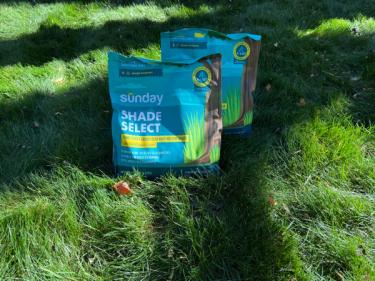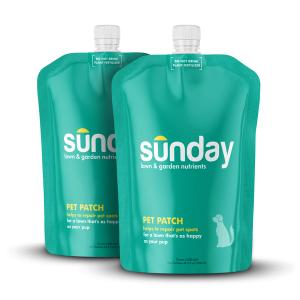I'm a scientist at Sunday, and these are my three favorite products: Shade Select grass seed, Grass Powerhouse liquid fertilizer, and Drought Defense soil surfactant.
1. Shade Select grass seed
This is my number one favorite product, and I recommend it to everybody. I bought 20 bags of Shade Select in the last four years. I always have some on hand at home, and I give it out to friends.
My goal is low maintenance
There's a saying that the cobbler's children have no shoes. That's how I feel about lawn care. I love working with our customers and helping them reach their goals, but I want a lawn that takes as little time as possible to look good. I don't choose Shade Select because it's shade-tolerant. The name is actually misleading in this case because it works in sunny and shady areas. I choose it because it's low-maintenance and low-input.
I don't have time to mow weekly or water a lot. Fine fescues grow slower and Shade Select consists mostly of fine fescue grasses: Chewing's fescue, red fescue, and hard fescue. I let my lawn grow really long and tall, probably 4-5 inches, until it starts to lay over. I only mow every three to four weeks. I like the look of the leaf blade. It's very thin, which is where “fine” fescues get their name. The fine fescues are underappreciated for how low-maintenance and low-input they can be.

Fall seeding time.
The fine fescues in Shade Select are allelopathic, so they keep out weeds naturally. They don't need a lot of fertilizer, and they don't need water beyond rainfall in Minnesota. Once established, they stay greener for longer, even when there's less water. I have sandy soils that don't hold water well, and fine fescues in general need less water to be happy. They also have no problem handling the harsh, cold winters.
Sunday Tip:
Have you heard of Fescue Rescue? Our Fescue Rescue seed mix has tall fescues in it, which are a different type of grass.
I’m an overseeder
Over the last few years, I've overseeded the original, very thin Kentucky bluegrass lawn with Shade Select three times annually. It actually only takes about 15 minutes for my average size lawn. I've shifted the balance from no fine fescue to at least 90% fine fescue. It looks great all times of the year. I think it's the best-looking lawn on my block in terms of color, uniformity, and density.
Shade Select is ALIST certified, so it's the top-performing fine fescue varieties for drought stress. These varieties are tested in multiple years at multiple locations across the country by a third party. The testing protocols don't use any pesticides, herbicides, or fungicides after establishment. Only top performers make our Sunday seed mixtures, and this is what sets them a level above.
2. Grass Powerhouse liquid fertilizer
If I could hack the Sunday custom lawn plan, I would want Grass Powerhouse six times in a row. My whole fertilizer subscription would just be Grass Powerhouse on repeat. I have healthy soil with good organic matter, so this is all I need.
The jungle juice of Sunday fertilizers
Grass Powerhouse has all the best ingredients: nitrogen, iron, and seaweed. None of our other pouches have this level of nitrogen in this combination. Joe Griebel, our Director of Physical Product, calls it the “jungle juice” of Sunday pouches. The nitrogen provides growth and density. The iron gives my lawn dark color and helps with some diseases. The seaweed is really beneficial for heat and drought stress, especially if you repeat applications. Honestly, you get a lot of bang for your buck on this product.
Grass Powerhouse is widely adaptable and well-rounded. You can apply this fertilizer any time during the growing season to any type of grass. We give this to nearly all of our customers. It's in most of our lawn plans at some point in the season.
3. Drought Defense soil surfactant

On my desk.
Make saving water easy
Wetting agents or soil surfactants are proven to improve water infiltration into the soil and the uniformity of soil moisture. There's loads of research on the benefits [1-4]. They improve turfgrass quality under deficit irrigation, sometimes requiring as much as 50% less water. In general, we consider surfactants to save 20% of water in treated areas.
I apply this before drought stress, before dry periods. If you wait until you're already seeing brown or dry grass, it's not going to be effective. The optimal application schedule would probably be monthly, but that's too high maintenance for me. I use this two to three times per year. Once around Memorial Day, once around the 4th of July, and once around Labor Day if it's a dry autumn. This helps me get the most out of rainfall events.
Sunday Tip:
We're working on a granular format for surfactants, which could make it more accessible to people who can't use a hose setup.
Cited sources
- Fidanza, M., Kostka, S., and C. Bigelow. 2020. Communication of soil water repellency causes, problems, and solutions of intensively managed amenity turf from 2000 to 2020. Journal of Hydrology and Hydromechanics 68:306-312.
- Nolan, G., and M. Fidanza. 2024. Evaluation of two soil surfactants for soil water management of creeping bentgrass on a wettable clay loam rootzone during an imposed dry-down period. Journal of Environmental Horticulture 42:40-45.
- Schiavon, M., and M. Serena. 2023. Advances in irrigation and water management of turfgrass. In Fidanza, M. (Ed.), Achieving sustainable turfgrass management.
- Schiavon, M., Orlinski, P., Petelewicz, P., Pudzianowska, M., and J. H. Baird. 2019. Effects of trinexapac-ethyl, surfactant, and nitrogen fertilization on bermudagrass water use. Agronomy Journal, 111:3057-3066.


















